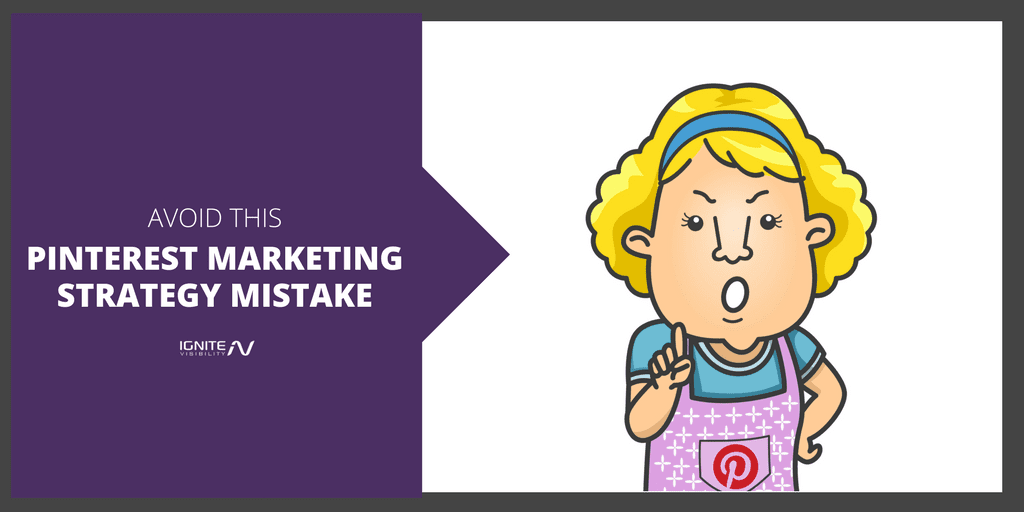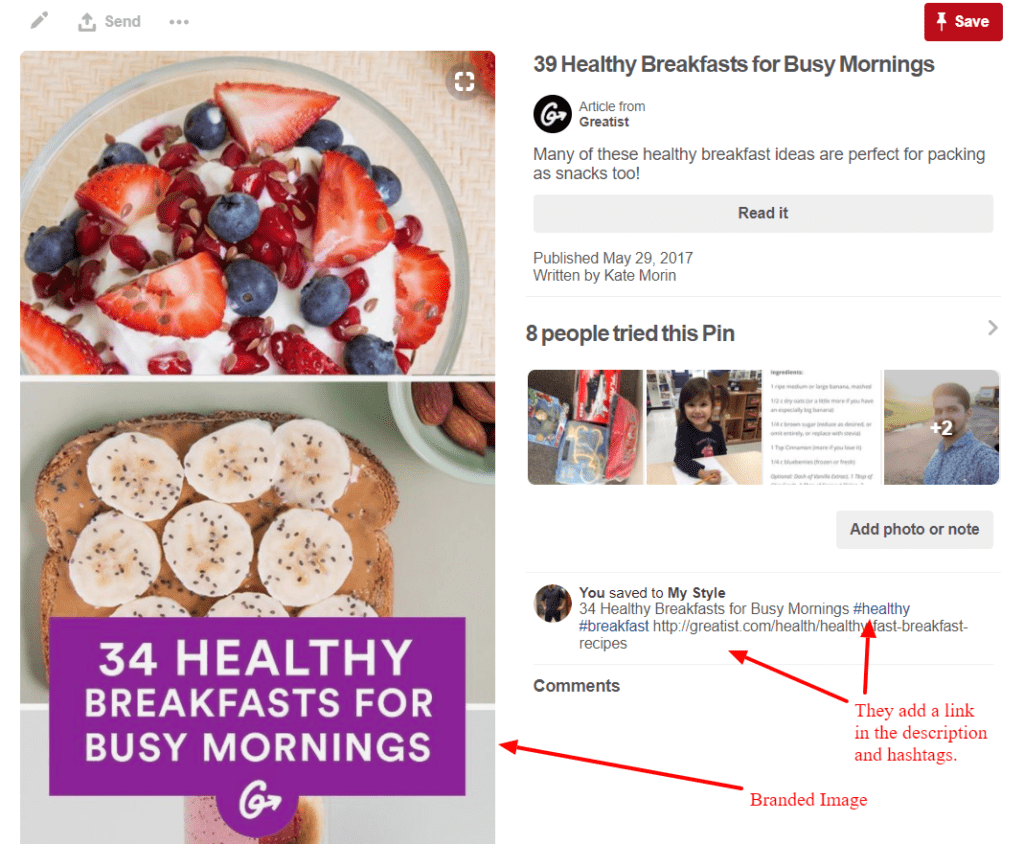Make this mistake with your Pinterest marketing strategy and there goes the value of the whole platform!
This article will cover the number 1 error most marketers aren’t talking about – and how you can avoid it.

Don’t make the mistake of ignoring Pinterest altogether. When used correctly, Pinterest can be an extremely valuable addition to your marketing strategy.
Generally speaking, people use the site to find inspiration, ideas, and often, new products.
In fact, more than two-thirds of Pinners say they’ve discovered a new product on Pinterest, and 93% use the platform to plan purchases.
Pinterest has an incredible influence on user’s purchasing decisions, second only to Facebook.
Which is why it’s incredibly important to make sure you’re doing it right.
The Biggest Pinterest Marketing Strategy Error
Unbeknownst to them, brands are using Pinterest to promote their competitors.
Instead of capitalizing on the valuable traffic their pins could produce, they’re sending it to the open doors of their competitors.
How? By listing the wrong source site in their pins.
A source site is the URL – generally your website or landing page – that your Pin is linked to.
When you create a pin on Pinterest, you should always include a link back to your website.
To add the source URL, simply hover over the pin you’ve uploaded and click the pencil icon that appears in the top right corner. Locate the “source” category from the pop-up box that appears, and enter the URL you wish to link your pin to.
Easy, right?
Unfortunately, excluding the source site is a common mistake made by many businesses on the platform, and could result in a major loss of potential traffic.
Think about it: you could watch your pin get repinned a thousand times, only to later realize that it has no effect on your website traffic because you forgot to include the URL.
Instead, marketers everywhere urge you to remember your URLs.
Okay. So we’re on the same page about source sites.
Now let’s talk about where they go wrong.
For that, we need to cover another common Pinterest best practice: Including pins from other sources (called re-pinning). After all, it’s never a good idea to exclusively self-promote on any social media site.
So you fill your boards with a mix of your own content, as well as content from others that you think will be relevant to your target audience.
The problem is, a lot of that content could potentially come from your competitors, and repinning their posts will likely send anyone who clicks on your repin straight to your competitor’s source site.
Another issue I see, is people forget to brand their pins. You really need to take the time do this. Greatist, a website we have worked with, does an excellent job here.
How to Avoid This Pinterest Marketing Strategy Mistake
First and foremost: repin carefully.
Don’t go blindly through and repin everything you see that relates to your business. Click on the image and its source website to make sure the author of the pin isn’t a competitor in your space.
In fact, repinning deserves its own strategy in itself. And planning it out requires a deep knowledge of your target audience.
As with any content you produce or share, before you hit the repin button make sure you can answer the following questions:
- Is this pin valuable to my followers?
- Is it likely that my followers will repin this pin?
- Who am I repinning from?
- Is it a competitor?
- Or, is it someone who could be interested in my business and become a follower?
- How many times has it been repinned? If something has been repinned multiple times, you’ll know it has been proven to be popular and may be popular with your audience as well
All this isn’t to say that you can’t use competitor pins to your advantage. That too just requires a little strategy.
First of all, following a competitor and monitoring their most popular pins will provide you with a little-needed inspiration to create your own. For example, if you see a great infographic by your competitor, don’t repin it. Instead, expand upon it and create your own with tools like Canva.
Other Pinterest Marketing Strategy Errors
- Not filling out your profile
While this is a common problem, it’s also an easy fix. When you first create your business profile, you’ll be given the option to include your business type, verify your website, add your location, and fill in a short “about me” section.
Make sure you fill in every category. Not only will it give your followers much-needed information about your business, but it will help your SEO performance as well.
- Not including a description and URL in each pin
Even when it comes to Pinterest, always follow SEO best practices. That means researching and identifying appropriate keywords and including them in your pin title, descriptions, and image file names. And remember, the more details and keywords you can include in your description, the more likely it is to be found in the search engine.
Also, try to include a call-to-action (often a call to repin) in your description, and include links where possible (and appropriate).
- Not promoting your Pinterest account and new pins
Any successful marketing channel requires a strategy for promotion, and Pinterest is no exception. Make sure you’re promoting pins on your other social media channels, and even include a section featuring your latest pins in your newsletters.
- Not separating content into boards
Pinterest 101: don’t dump all your content into one board. Separate by topic and interests that you’ve decided are most relevant to your audience. Also, for each board you create, remember to select an appropriate category for it. This will help your followers search for your content, as well as make it as easy as possible to find the particular pins they’re looking for. This is also another time to keep SEO in mind, and try to give each of your boards a title that users would naturally search for.
- Posting low-quality images
Another mistake that’s easy to avoid: don’t post low-res or unprofessional pins. Nothing earns fewer shares and repins than a sloppy image, so always keep in mind:
- Use high-quality images
- Think about using vertical photos (they tend to look better on mobile devices)
- Keep any text on the pin to a minimum
When in doubt, use Canva’s Pinterest template to create and size your images.
- Not pinning more than once
This is social media, remember. Things happen fast, and posts often get overlooked. To avoid getting lost in the shuffle, remember to post your pins multiple times to maximize the number of eyes on it.
- Not connecting with your other social media accounts
Good news here: you don’t have to start from scratch. Instead, you can connect your Pinterest page to your other social media accounts. This will allow you to share your Pins on Facebook and Twitter, and tap into your existing social media followers. Full directions are listed here. Keep in mind, you can currently only connect to personal Facebook accounts, not business pages.
- Not using rich pins
Rich pins, in a way, are similar to Google ad extensions: They take a regular post and add in additional information right in the Pin, and help your user’s determine what your Pin is about and how it applies to them.

There are four types of rich pins you can use: app, product, recipe and article.
- Not including prices in your Pins
Here’s another easy trick: if you’re posting product pictures, include the price in the description. Why? Because Pinterest pins with prices get 36% more likes than those without.
- Not timing your Pins
To make the most of each pin, you need your followers to find it. Make sure they do so by finding out which times see the highest engagement. Start by experimenting with different times, and tracking your audience engagement through your Pinterest analytics. As a starting point, Hubspot reports that the best time to post on Pinterest is between 8-11PM on Saturdays.
Also remember to keep your posts consistent; for Pinterest, it’s recommended to post once per day.
- Not using Pinterest if you’re a B2B
Yes, Pinterest’s best known for recipes and home renovations; but if you’re a B2B, don’t make the mistake of ignoring it. Use it to post blog images, ebook covers, infographics, industry stats, and much more.
Get Started With Your Pinterest Marketing Strategy
With the right strategy in place, Pinterest can be a valuable asset to any business.
And if you remember to keep your competition out of your pins, you’ll already be a step ahead of the game.



/2013%2F05%2F08%2F0d%2Fpinterestbh.93b07.jpg)